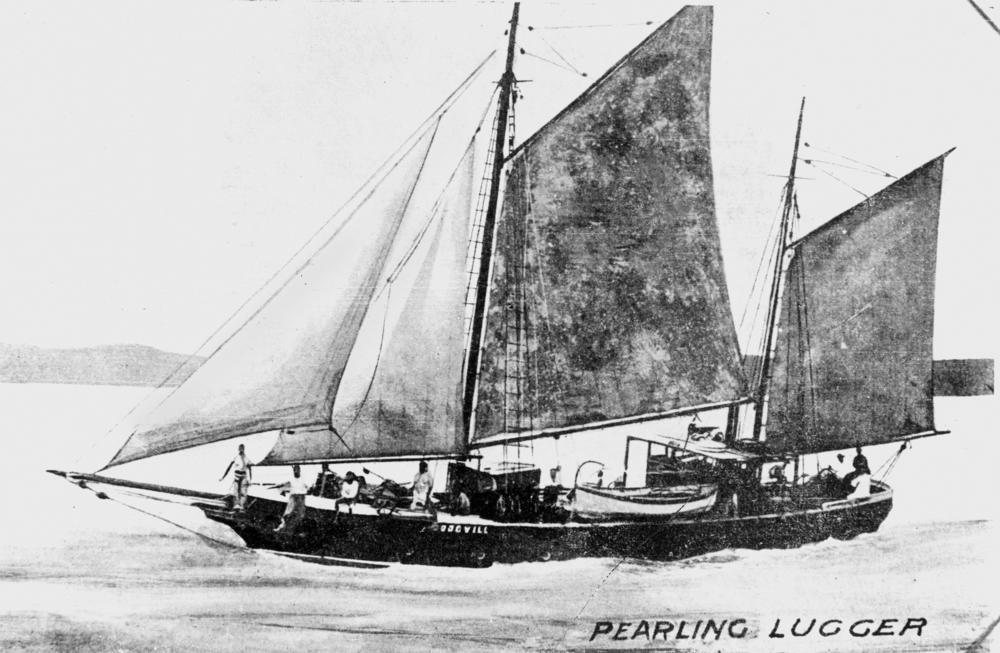Pearling Luggers of the Torres Strait
By Christina Ealing-Godbold, Research Librarian, Information Services | 19 November 2014
The romance of the beautiful pearling luggers of the Torres Strait is captured in the photographs and resources held by State Library of Queensland.

The luggers were gaff-rigged ketches constructed of wood, and many have continued to sail for more than 60 years. Typically measuring 15 to 20 meters in length, with low waists and bulwarks to assist diving, the two- masted pearling luggers were graceful with curved lines. They were a magnificent sight as they entered the open sea under full sail. There were many hundreds of luggers working across the north of Australia, from Thursday Island to Broome. Many of the luggers were built by Japanese shipwrights on Thursday Island. Indeed, by the turn of the century, the Japanese had a monopoly on the shipbuilding and slipways of the island. The Queensland Museum has examined the woods used in the luggers, and has found that typically a mixture of native timbers was used, including melaleuca, turpentine, hoop pine and sometimes imported timbers such as oregon pine. The Queensland Maritime Museum at South Bank has restored a pearling lugger that was built on Thursday Island in 1907. Called Penguin, it was a working boat for more than 80 years.
Pearling was enormously important to the economy of northern Australia. Beginning in 1868 in the Torres Strait, the industry had a boom and bust cycle, with high points being experienced in the 1870s and 1890s. While pearls were prized, the basis of the industry was the pearling shell, which was in great demand in Australia, America and Europe for buttons, combs, jewellery, insets in furniture and cutlery set handles. At one point in the early 1870s, the price of £400 per ton was reached for pearl shell. The pearling industry of northern Australia supplied the majority of the world’s need for pearl shell, and was a source of great wealth for some of the fleet owners.
The luggers worked in fleets. Pearling fleets were multi-national affairs, manned by Torres Strait Islanders, Malays, Indians, Sri Lankans and Japanese, as well as some workers from other Pacific Islands. The pearling fleet masters were principally Australians and New Zealanders, including James Clarke, Tommy Farquhar and the Hockings Brothers. Each fleet could have more than 20 luggers, with several schooners providing supplies to the luggers. Each fleet was painted in identifying colours. For example, the Farquhar fleet had black hulls with red and white railings. The name and registration number of each boat was carved into the side, near the bow.

Typically, a pearling lugger had two or three divers, two or three tenders to operate the air pumps, a cook, an engineer and two sailing crew. The divers, who were mostly Japanese, risked their lives in rubberised canvas suits, heavy boots laden with lead, and helmets with thick glass. The divers were paid according to the amount of shell they collected, so every minute on the bottom was precious.
Their lives were in the hands of the tenders above, who operated the air pumps to keep them alive. Initially, pearl shell was easily located in shallow waters. However, by 1871, a diving suit was designed, allowing access down to 20 fathoms. As the pearl shell was collected over many years, the remaining shell deposits were at increasingly greater depths, and by the end of the 1930s, divers were going down to 40 fathoms in areas such as the Darnley Deeps. Few Australians could be attracted to the perilous occupation of pearl diving. The bends killed many of the divers, as did shark attacks. In 1916, the official death rate in workplaces in Queensland was reported as 1.1% of the workforce, contrasting with the 10% quoted for pearling divers. Cyclones were also a threat to the safety of the pearling fleets, with one cyclone in1899 sinking more than 50 luggers, and killing 300 men.
During World War Two, the pearling luggers were requisitioned by the Australian Navy, as the islands of the Torres Strait became strategically very important. Many were used by the Americans, patrolling the Torres Strait. The residents of the islands were evacuated from 1942 until 1946. After the war, it was difficult for the industry to rebuild, and the introduction of plastics made the industry less viable, causing many luggers to be sold and refitted for prawning, crayfishing or other commercial activities. Some pearling continued until the 1970s, with the introduction of cultured pearling.
The sailing boats once used to trawl for the treasures of the sea are a reminder of Queensland’s past. Resilient craft, many of the pearling luggers were refloated, refitted and continued to sail many years after the pearling industry had become a remnant of our history.
Christina Ealing-Godbold, Senior Librarian, Information Services

Comments
Your email address will not be published.
We welcome relevant, respectful comments.